Family: Asteraceae
Genus: Matricaria
Species: chamomilla
Synonyms: Matricaria recutita, Chamomilla recutita
Common Names: Chamomile, German Chamomile, Amerale, Babunnej, Bayboon, Camomile, Kami-Ture, Manzanilla Dulce, Manzanilla, Papatya
Parts Used: Whole herb, especially the flowers
Habitat: Grows abundantly as a wild herb in the dry, open fields of India.
Traditional Significance
Chamomile holds a remarkable place in history, celebrated since ancient times for its healing properties. The Egyptians revered this herb, associating it with the Sun, and used it extensively for medicinal and religious purposes. Notably, Chamomile pollen was discovered in the stomach of the great Pharaoh Ramses II, underlining its ancient importance.
Greek physicians, including Hippocrates, employed Chamomile to treat fever, women’s health concerns, and nervous disorders. Across cultures and centuries, Chamomile has remained a staple in herbal medicine, widely used for skin conditions, respiratory ailments, and emotional well-being.
Description and Energetics
Chamomile is a fragrant, daisy-like plant with delicate white petals surrounding a yellow center. Its flowers are harvested for their medicinal value. The herb is traditionally considered warming and drying, with a taste that is sweet and slightly bitter.
Medicinal Uses
Chamomile is one of the most cherished herbal remedies known for its calming, anti-inflammatory, and antispasmodic properties. It addresses both common everyday discomforts and more persistent health concerns:
-
For Nervous Disorders: Chamomile soothes anxiety, irritability, and restlessness. Particularly beneficial for those with a low pain tolerance, prone to anger, impatience, and hypersensitivity when ill.
-
Children’s Ailments: Excellent for teething troubles in children, especially when accompanied by fever, irritability, and an urgent need to be carried.
-
Pain Relief: Useful for toothaches that worsen with heat and improve with cold applications. It’s also effective in cases of earache with a blocked sensation and menstrual cramps with heavy bleeding.
-
Digestive Issues: Acts as a gentle remedy for colic, indigestion, nausea, and sleeplessness, especially in children.
-
Skin Care: Chamomile’s soothing and anti-inflammatory action makes it ideal for treating eczema, inflamed nipples during breastfeeding, and other skin irritations.
Chamomile in Electropathy (E.H.)
In Electropathy, Matricaria chamomilla is an essential constituent of Scrofoloso Nos. 1 to 6. It’s revered for its ability to relieve all types of pain and bring tranquility to the nervous system, promoting overall emotional balance and physical comfort.
Conclusion
Chamomile’s versatility and gentle effectiveness make it a treasured herb in natural healing systems across the world. From ancient Egyptian rituals to modern herbal teas and remedies, its calming, pain-relieving, and skin-soothing benefits continue to be valued by practitioners and everyday users alike.
Speech Disorder
A speech disorder, also known as a speech impairment...
ADHD
Attention-deficit / hyperactivity disorder (ADHD) is a...
Cerebral Palsy(CP)
Cerebral palsy (CP) is a group of neurological disorders...
Cancer
Cancer is a broad term for diseases where cells...




